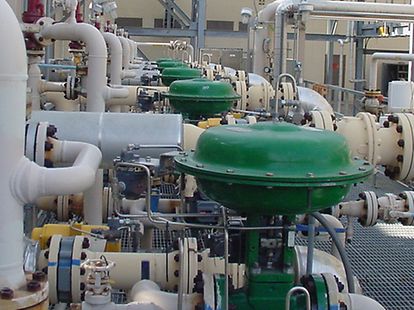Selecting the Right Control Valves: A Guide to Optimum System Performance
Selecting the Right Control Valves: A Guide to Optimum System Performance
Blog Article

Maximize Energy Savings and Comfort With Advanced Building Automation Controls
In the world of modern-day style and center monitoring, the combination of innovative structure automation controls stands as a crucial advancement. By harnessing the power of automation, buildings can adapt, react, and advance in means that were when unimaginable.
Energy Efficiency Advantages
Energy efficiency benefits can dramatically lower energy consumption and functional prices in structures. Energy-efficient systems, such as sophisticated structure automation controls, can enhance the use of resources like home heating, cooling, and illumination, leading to lower energy expenses over time.
In addition, boosted energy performance can extend the life-span of structure tools and systems. By operating more successfully, heating and cooling systems, lighting fixture, and various other structure parts experience less wear and tear, causing lowered upkeep and replacement costs. In addition, energy-efficient buildings frequently command greater residential or commercial property values and rental rates, giving lasting economic benefits to proprietors.
In addition, power effectiveness can improve owner comfort and productivity. Appropriately managed indoor environments with optimum illumination and thermal problems develop an even more pleasant and conducive work space, leading to boosted employee complete satisfaction and performance. In general, the power effectiveness benefits connected with sophisticated building automation controls are diverse, encompassing cost savings, environmental stewardship, and owner wellness.
Enhanced Comfort Control
Enhancing comfort control in building atmospheres needs an innovative assimilation of advanced automation systems for optimal passenger health. By utilizing sophisticated building automation controls, centers can tailor the interior setting to meet the certain demands and preferences of passengers. These systems allow exact guideline of illumination, air flow, and temperature level, developing a efficient and comfy environment. Passenger fulfillment and efficiency are closely connected to thermal convenience, making it important to have systems in position that can adapt to altering problems in real-time.
Improved convenience control surpasses basic temperature level changes. It includes functions such as personalized settings, occupancy sensing units, and all-natural light use to produce a dynamic and receptive environment. By incorporating these sophisticated controls, structures can not only boost comfort yet likewise improve energy efficiency by maximizing system procedures based upon actual tenancy and use patterns. Inevitably, focusing on passenger comfort through advanced automation systems brings about an extra enjoyable and healthier indoor atmosphere.
Functional Performance Improvements

In addition, the execution of real-time tracking and analytics devices makes it possible for structure operators to determine energy inadequacies and functional abnormalities immediately. By continuously keeping an eye on energy usage patterns and system performance metrics, modifications can be made in real-time to maximize energy intake and guarantee peak operational efficiency. control valves. Furthermore, integrating demand reaction techniques right into structure automation controls can better improve functional performance by dynamically readjusting energy use based upon grid problems and pricing signals
Indoor Environment Optimization
Efficient interior climate optimization is an essential element of structure automation controls, making certain occupants' comfort and wellness while maximizing power financial savings. By making use of sophisticated sensors and controls, developing automation systems can continually adjust and monitor temperature level, moisture levels, air quality, and ventilation to create an optimal interior atmosphere. Maintaining consistent and comfy conditions not only boosts occupant satisfaction however also boosts productivity and general wellness.
Interior climate optimization likewise plays an essential role in power effectiveness. By fine-tuning ventilation, home heating, and air conditioning systems based on real-time information and occupancy patterns, developing automation controls can dramatically reduce energy intake - control valves. For example, carrying out techniques such as demand-controlled air flow and thermal zoning can assist lessen power waste while making certain that each location of the structure receives the necessary conditioning.

Sustainable Setting Production
Structure automation regulates not only optimize indoor climate problems for power performance and resident comfort however additionally lay the foundation for creating a lasting environment through calculated administration of sources and systems. By integrating sophisticated building automation technologies, such as sensors, actuators, and smart software, centers can readjust and keep track of power usage in real-time to reduce waste and reduce their carbon impact. These systems allow anticipating maintenance, recognizing possible concerns prior to they escalate and enhancing equipment performance to improve durability and performance.
Moreover, lasting atmosphere development prolongs past power monitoring to incorporate water preservation, waste reduction, and indoor air top quality improvement. Building automation controls can manage water usage, detect leaks, and ensure correct visit site garbage disposal practices, adding to general sustainability efforts. Furthermore, by managing and keeping an eye on ventilation and purification systems, these modern technologies boost passenger wellness and performance while decreasing power intake connected with heating and cooling operations.
Conclusion
To conclude, progressed structure automation controls deal significant benefits in terms of power financial savings, comfort control, functional effectiveness, interior climate optimization, and producing a sustainable atmosphere. By carrying out these controls, structures can achieve optimal efficiency while minimizing power intake and enhancing owner convenience. It is obvious that the use of sophisticated automation modern technology is important in enhancing structure efficiency and creating a more sustainable future.
Energy performance benefits can dramatically reduce power intake and functional costs in structures. On the whole, the energy effectiveness advantages connected with innovative structure automation controls are diverse, visit the website encompassing cost savings, ecological stewardship, and occupant health.
Additionally, incorporating demand response approaches into structure automation controls can additionally enhance operational effectiveness by dynamically readjusting power usage based on grid problems and rates signals.
Building automation controls not just enhance indoor environment problems for energy efficiency and owner comfort but also lay the foundation for developing a lasting environment with strategic administration of systems and resources.In final thought, advanced building automation manages offer substantial benefits in terms of power cost savings, comfort control, operational efficiency, link indoor environment optimization, and developing a sustainable setting.
Report this page